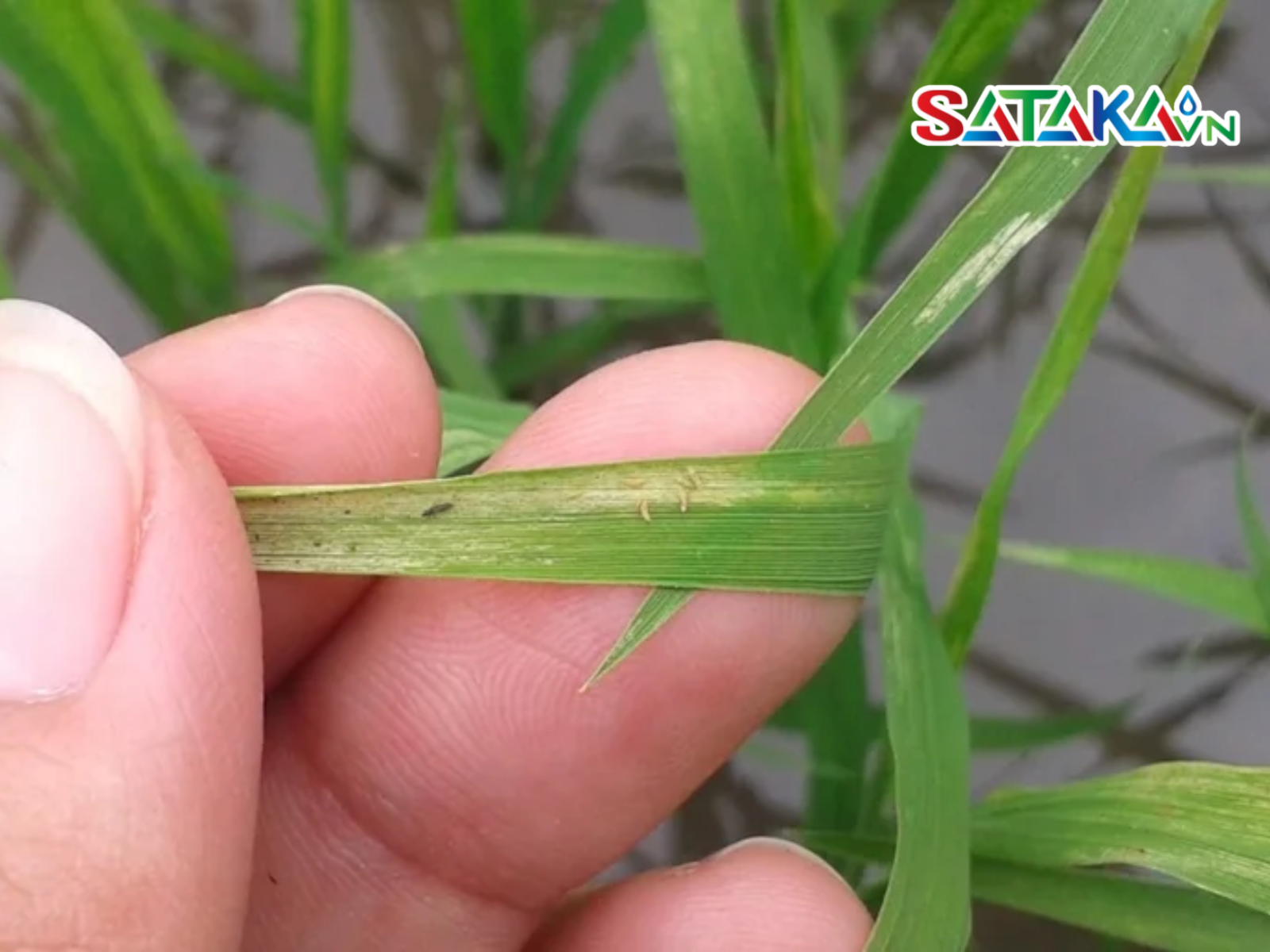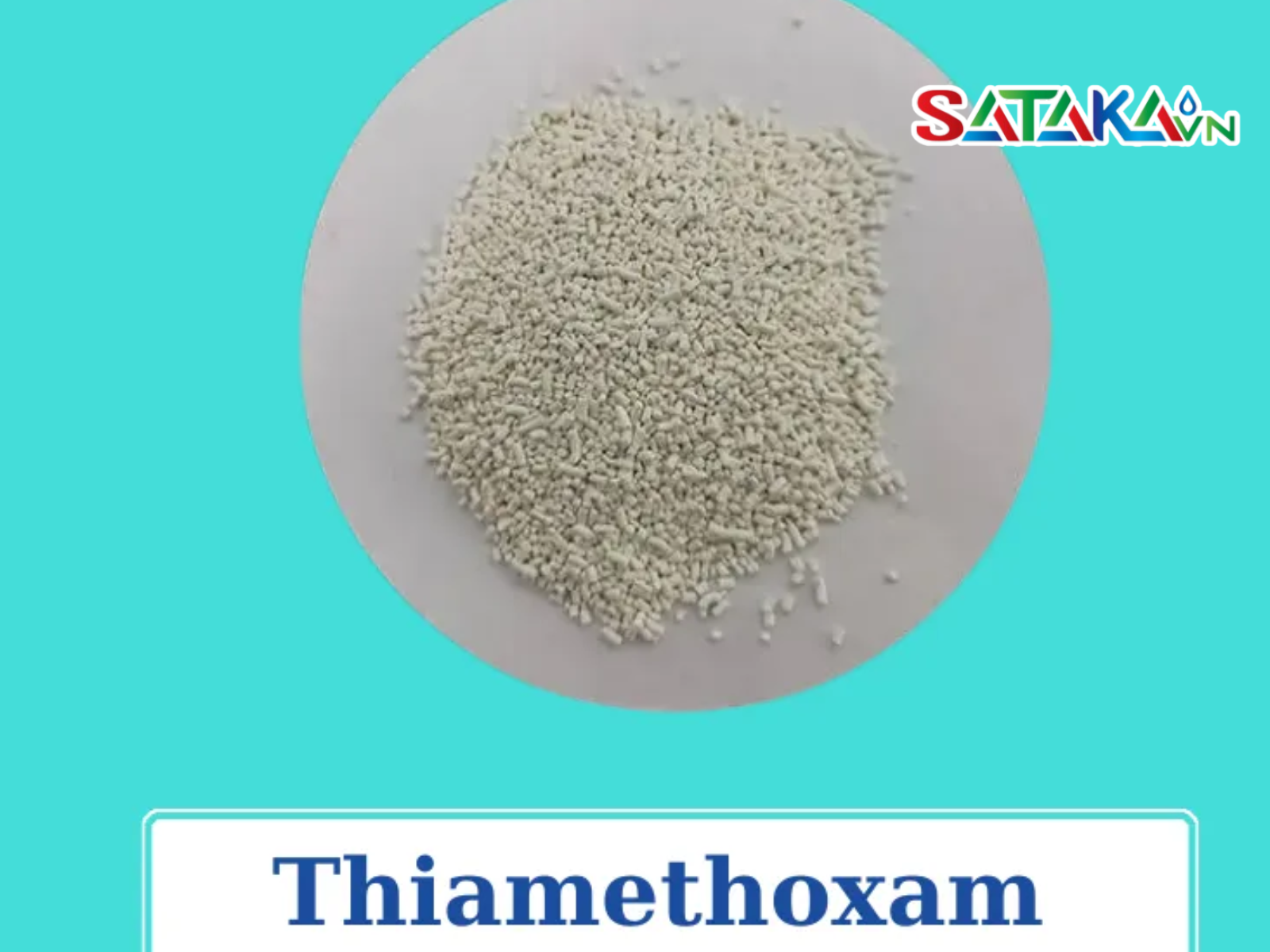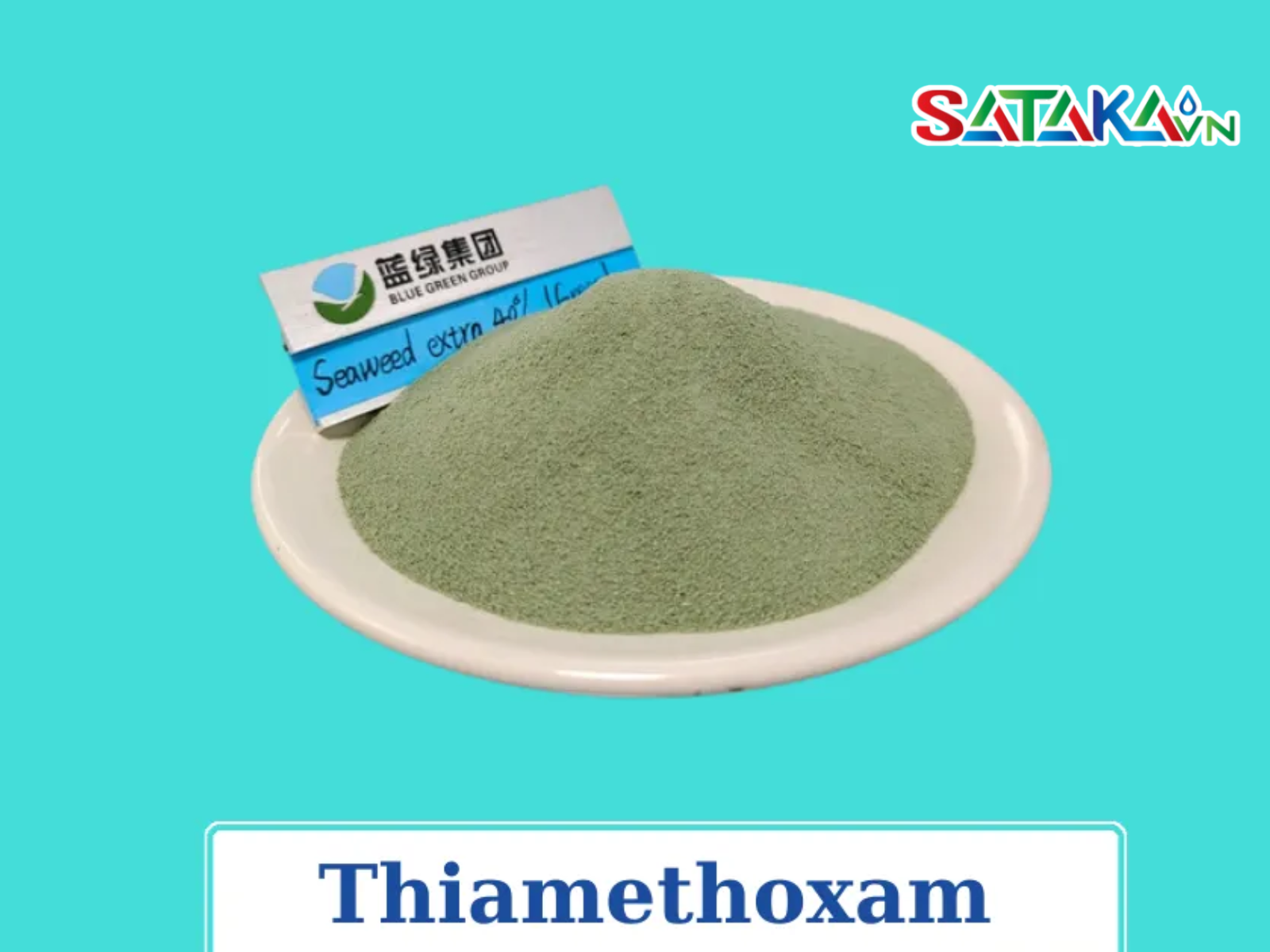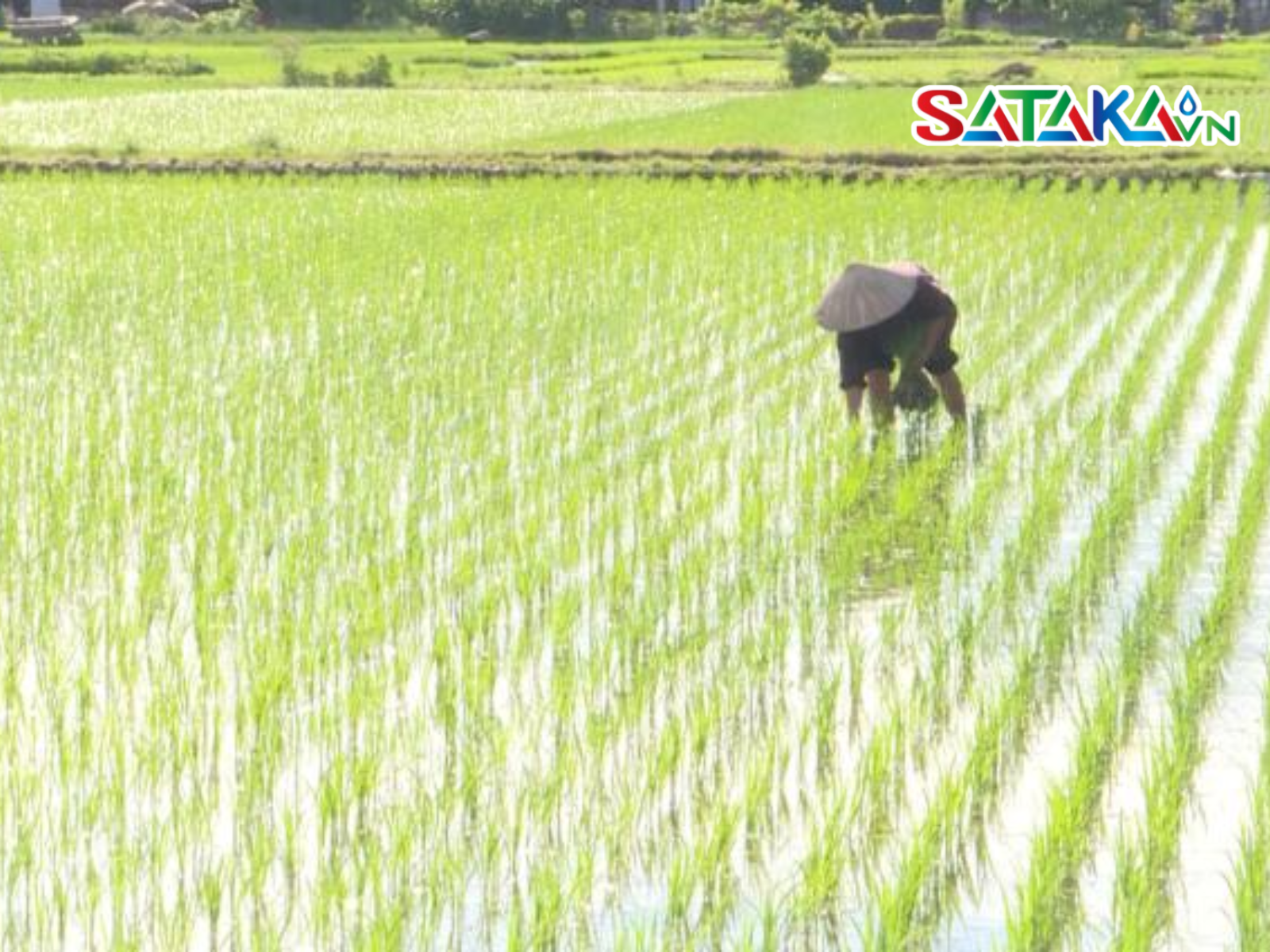Learn about Thiamethoxam for controlling thrips in rice, its benefits, and how to use it safely and effectively. Contact SataKa Joint Stock Company for expert advice and to order quality products.
Thiamethoxam Effectively Controls Thrips in Rice
Thrips have become a serious threat to rice cultivation in Vietnam, damaging crops from the seedling stage to early tillering, significantly reducing both yield and quality. Thiamethoxam has emerged as an effective solution trusted by many farmers due to its rapid action and long-lasting protection. In particular, Thiamethoxam-based products from Sataka Vietnam are highly regarded for their quality and effectiveness, helping farmers protect their crops, increase productivity, and reduce economic losses.
1. Overview of Thrips and Their Impact on Rice
Thrips are among the most common and harmful pests affecting rice crops in Vietnam. Their presence not only directly lowers yields but also affects grain quality, posing significant challenges for farmers.
1.1 Characteristics and Life Cycle of Rice Thrips
Thrips (Stenchaetothrips biformis) are tiny insects, about 1–2mm in length, with slender bodies ranging from pale yellow to dark brown. Their life cycle typically includes five stages: egg, two larval stages, two pupal stages, and adult.
Notable characteristics of thrips include:
- Short life cycle: Only about 15–20 days under favorable conditions
- High reproductive rate: Each female can lay 50–100 eggs
- Rapid development: Thrive in dry, hot weather with low humidity
Thrips usually attack rice from the seedling to tillering stages, mainly targeting the undersides of leaves and leaf sheaths, where they can hide and feed.
1.2 Damage Caused by Thrips to Rice Yield and Quality
Thrips damage rice plants by piercing leaf cells and sucking out the sap, leading to serious consequences:
- Leaf discoloration: Affected leaves show white spots that turn yellow and eventually dry out
- Reduced photosynthesis: Damaged leaf areas cannot perform photosynthesis effectively
- Stunted growth: Plants become weak and shorter in height
- Lower yields: Crop loss can reach 30–40% if left uncontrolled
- Virus transmission: Thrips also act as vectors for certain rice viruses
When thrips infest in high numbers, leaf surfaces may appear scratched, leaf margins curl, and in severe cases, seedlings may die, especially during early growth stages.

Overview of Thrips and Their Impact on Rice
2. Introduction to the Active Ingredient Thiamethoxam
Thiamethoxam is an active ingredient belonging to the neonicotinoid group, widely developed and applied in the field of crop protection. It is especially effective in controlling piercing-sucking insects such as thrips on rice plants.
2.1 Characteristics and Mode of Action of Thiamethoxam
Thiamethoxam has the chemical formula C₈H₁₀ClN₅O₃S and is a new-generation insecticide with several outstanding features:
- Strong systemic activity: After spraying, the active ingredient is absorbed by the plant and translocated to other parts of the plant.
- Mode of action: It targets the insect’s nervous system by binding to nicotinic acetylcholine receptors (nAChRs).
- Dual efficacy: Works through both contact and ingestion, causing insects to become poisoned either by touching or consuming treated surfaces.
- Deep penetration: Easily passes through the leaf’s cuticle, providing comprehensive protection.
When insects come into contact with Thiamethoxam, it binds to their acetylcholine receptors, disrupting their nervous system. This causes the pests to stop feeding, become paralyzed, and eventually die.
2.2 Advantages of Thiamethoxam in Controlling Thrips
Thiamethoxam stands out for its multiple superior advantages in thrips management on rice:
- Rapid action: Kills thrips just a few hours after application
- Broad-spectrum control: Effective against many types of piercing-sucking insects
- Long-lasting protection: Safeguards crops for up to 10–14 days with a single spray
- Rainfastness: Excellent adhesion properties, minimally affected by rain
- High selectivity: Safe for many beneficial organisms in rice fields
- Low resistance risk: Thrips are less likely to develop resistance compared to older classes of insecticides
At Sataka Viet Nam, Thiamethoxam-based products are further enhanced with advanced formulation technology, boosting both effectiveness and safety when used in real farming conditions.

Introduction to the Active Ingredient Thiamethoxam
3. Effectiveness of Thiamethoxam in Controlling Thrips on Rice
Thiamethoxam has consistently demonstrated outstanding efficacy in thrips control over many years of use, making it the preferred choice for many rice-specialized farmers.
3.1 Targeting Multiple Life Stages of Thrips
Thiamethoxam works against nearly all developmental stages of thrips, ensuring comprehensive pest control:
- Kills adults: Adult thrips stop feeding and die within 6–12 hours of contact
- Eliminates larvae: Larval stages are more sensitive and are quickly eradicated
- Reduces reproduction: Lowers the egg-laying capacity of female thrips
- Prevents spread: Controls population early, preventing future outbreaks
Field trials have shown that when applied at the correct dosage and timing, Thiamethoxam achieves 85–95% thrips mortality, outperforming many other active ingredients.
3.2 Residual Activity and Lasting Protection
One of the most notable strengths of Thiamethoxam is its long residual activity, which provides prolonged crop protection:
- Fast-acting: Starts killing thrips within 4–6 hours after application
- Lasting control: Maintains protection for 10–14 days after spraying
- Systemic movement: Moves through the plant’s vascular system to protect new growth
- Weather resistance: Quickly absorbed into plant tissues, making it less likely to be washed away by rain
Thanks to its systemic and long-lasting effects, Thiamethoxam reduces the need for frequent applications, helping farmers save time, labor, and costs, while minimizing environmental impact.
Explore: How Effective Is Acetamiprid In Controlling Brown Planthoppers In Rice?
4. Safe and Effective Use of Thiamethoxam
To maximize thrips control while ensuring safety, it is essential to follow proper usage guidelines when applying Thiamethoxam.
4.1 Recommended Dosage and Application Methods
Dosage and application depend on the formulation, pest pressure, and the growth stage of the rice plant:
- Granular form: Apply 3–5 kg/ha evenly before sowing or transplanting
- Spray formulation: Use a 0.15–0.2% concentration, equal to 30–40 ml of 25% EC product per 16 liters of water
- Water volume: Apply 400–500 liters/ha to ensure thorough and even coverage
- Spray method: Focus on the undersides of leaves and leaf sheaths, where thrips often hide
- Spray frequency: Typically 1–2 times per crop, spaced 10–14 days apart if pest pressure is high
Avoid over-concentrating the solution beyond recommended rates to prevent phytotoxicity (plant damage) and unnecessary waste.
4.2 Optimal Timing for Application
The timing of Thiamethoxam application plays a crucial role in controlling thrips effectively:
- Seedling stage: Spray when thrips appear at 1–2 insects per clump
- Tillering stage: Spray when populations reach 3–5 insects per clump, or 10–15% of leaves show damage
- Time of day: Apply in the early morning or late afternoon, avoid spraying during hot, sunny periods
- Weather conditions: Do not spray if rain is expected soon or if strong winds are present
- Preventive application: Consider preventive spraying in areas with a history of thrips infestation
Early application, when thrips first appear, significantly increases control success and helps prevent large-scale outbreaks.
4.3 Safety Precautions When Using Thiamethoxam
Although Thiamethoxam is relatively safe, users should still follow essential safety measures:
- Wear protective gear: Use gloves, masks, safety goggles, and long-sleeved clothing when mixing and spraying.
- Post-use hygiene: Wash hands, face, and any exposed skin thoroughly with soap and water.
- Pre-harvest interval: Observe a withholding period of 7–10 days before harvest.
- Packaging disposal: Collect and dispose of packaging as per local regulations; do not litter.
- Avoid cross-contamination: Do not reuse spraying equipment for other chemicals unless thoroughly cleaned.
- Do not spray close to flowering time: To protect pollination and beneficial pollinators, avoid spraying Thiamethoxam just before the flowering stage.

Safe and Effective Use of Thiamethoxam
5. Thiamethoxam-Based Products from Sataka
Sataka Vietnam Joint Stock Company is a reputable provider of high-quality crop protection products, including a range of solutions containing Thiamethoxam to effectively manage thrips in rice.
5.1 Available Thiamethoxam Product Lines
Sataka offers a variety of Thiamethoxam-based formulations and concentrations to meet the diverse needs of farmers:
- Thiamethoxam 25WG: Water-dispersible granules, highly effective for thrips control
- Thiamethoxam 350FS: Concentrated suspension for seed treatment
- Thiamethoxam + Lambda-cyhalothrin: Dual-action formula for enhanced pest control
- Satathiam 25WG: A proprietary Sataka product using advanced formulation technology
Products are available in various pack sizes (10g, 20g, 100g), suitable for both small-scale and large-scale farming operations, allowing farmers to choose based on their actual needs.
5.2 Quality and Reputation of Sataka Products
Thiamethoxam-based products from Sataka stand out with multiple advantages:
- High-quality ingredients: Sourced from reputable international suppliers
- Modern manufacturing technology: Produced under internationally certified processes
- Strict quality control: Each batch is carefully inspected to ensure performance
- Consistent efficacy: Balanced formulation ensures stable and reliable results
- Extensive distribution network: Available at most trusted agrochemical dealers nationwide
Sataka also provides ongoing support through technical advisory programs, helping farmers use products effectively and safely for optimal crop protection.
6. Effective Thiamethoxam Mixtures for Enhanced Pest Control
To boost effectiveness against thrips and other pests, Thiamethoxam is often combined with other active ingredients to create multi-action formulations.
6.1 Thiamethoxam + Lambda-cyhalothrin
Combining Thiamethoxam with lambda-cyhalothrin results in an exceptional formula:
- Dual mechanism: Thiamethoxam acts systemically, while lambda-cyhalothrin works through contact and ingestion
- Rapid knockdown: Lambda-cyhalothrin quickly eliminates pests, while Thiamethoxam ensures long-term control
- Wider spectrum: Effective not only on thrips but also on brown planthoppers and leafrollers
- Resistance management: Different modes of action help delay resistance development
- Recommended dosage: Typically 20–25g per 16 liters of water; spray when thrips are detected
Field trials show this combination achieves 90–95% control, 10–15% higher than using individual actives.
6.2 Other Effective Combinations with Thiamethoxam
Besides lambda-cyhalothrin, Thiamethoxam can also be effectively combined with:
- Thiamethoxam + Imidacloprid: Enhanced systemic action and prolonged protection
- Thiamethoxam + Abamectin: Broader spectrum, effective on both sucking and chewing pests
- Thiamethoxam + Buprofezin: Dual effect – direct kill and inhibition of molting
- Thiamethoxam + Dinotefuran: Strengthened control for resistant pest populations
Usage guidelines:
- Follow recommended mixing ratios
- Avoid mixing multiple pesticides without prior compatibility tests
- Monitor crop response when applying new combinations
Sataka offers pre-mixed formulations with optimal ratios for convenience and maximum efficacy.

Effective Thiamethoxam Mixtures for Enhanced Pest Control
7. Economic Benefits of Using Thiamethoxam for Rice
Using Thiamethoxam not only delivers technical results but also brings significant economic advantages for farmers.
7.1 Cost-Effectiveness Compared to Other Methods
When compared to other thrips control methods, Thiamethoxam proves highly cost-effective:
- Application cost: Around 200,000–300,000 VND/ha per application, equal to or less than many alternatives
- Fewer sprays required: Usually only 1–2 sprays per crop due to long residual effect
- Reduced labor: Less spraying means lower labor costs
- Comprehensive pest control: Manages multiple pests, reducing need for separate treatments
- Lower risk of crop loss: Higher success rate in preventing damage ensures yield protection
Field data shows that with an investment of 200,000–300,000 VND/ha, farmers can increase income by 1.5–3 million VND/ha by minimizing thrips-related damage.
7.2 Yield and Quality Improvements After Thiamethoxam Application
Effective thrips control with Thiamethoxam leads to significant gains in yield and rice quality:
- Increased yield: On average 5–10% higher yield compared to untreated or poorly treated fields
- Improved grain quality: Fuller grains, reduced proportion of empty grains
- Higher grain density: Plumper rice grains, 3–5% higher solid kernel rate
- Better grain appearance: More attractive grains, less discoloration caused by thrips
- Higher market value: Better-quality rice fetches higher selling prices
These benefits not only improve income in the current season but also help farmers build a reputation for high-quality rice, creating long-term competitive advantages in the market.
8. Conclusion
Thiamethoxam has proven to be a vital tool in controlling thrips on rice in Vietnam. With a high control rate of 85–95%, long residual activity of up to 14 days, and comprehensive protection, Thiamethoxam not only manages pest populations effectively but also delivers substantial economic returns to farmers.
When applied at the right dosage, timing, and method, Thiamethoxam offers optimal pest control while ensuring safety for users and the environment. With rigorously tested product quality and professional technical support, Sataka Vietnam’s Thiamethoxam-based products are a reliable choice for farmers committed to protecting their crops and improving rice production outcomes.
SATAKA VIETNAM JOINT STOCK COMPANY
Address: No. 246 Nguyen Kim Cuong, Tan Thanh Dong Commune, Cu Chi District, Ho Chi Minh City
Hotline: 0856.555.585 or 0789.917.927
Website: https://sataka.com.vn/



